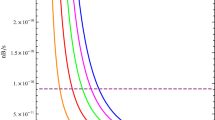Summary
Mach’s principle is viewed as being incorporated into relativity by means of Dicke’s scalar field theory. The assumption is made, however, that the scalar field interacts only with baryonic matter. Then it follows that the baryon current obeys an equation of continuity. Furthermore, by adopting the steady-state model of the Universe, the baryon mass becomes determined by the scalar field. Thus, both baryon conservation and the origin of the baryon mass can be regarded as a consequence of Mach’s principle. In order to ensure the unrestricted validity of the equivalence principle, one must allow for a pressure in the matter fields. Various cosmological consequences are discussed.
Riassunto
Si considera il principio di Mach incorporato nella relatività per mezzo della teoria del campo scalare di Dicke. Si fà, tuttavia, l’ipotesi che il campo scalare interagisca solo con la materia barionica. Ne segue che la corrente barionica obbedisce ad un’equazione di continuità. Inoltre, adottando il modello di stato stazionario dell’universo, la massa del barione viene determinata dal campo scalare. Cosi, si possono considerare la conservazione dei barioni e l’origine della massa barionica come conseguenze del principio di Mach. Allo scopo di assicurare la validità senza restrizioni del principio di equivalenza, si può ammettere che esista una pressione nei campi di materia. Si discutono varie conseguenze cosmologiche.
Similar content being viewed by others
References
P. A. M. Dirac:Troc. Boy. Soc, A165, 199 (1938).
J. S. Bell andJ. K. Peering:Phys. Bev. Lett.,13, 348 (1964).
T. D. Lee andC. N. Yang:Phys. Rev.,98, 1501 (1955).
E. H. Dicke:Phys. Rev.,126, 1580 (1962).
J. Schwinger:Phys. Bev.,125, 397 (1962). See also,J. J. Sakueai:Ann. Phys.,11, 1 (1960); andP. Eoman:Nuovo Cimento,21, 747 (1961).
C. Brans andE. H. Dicke:Phys. Rev.,124, 925 (1961).
E. H. Dicke:Phys. Rev.,125, 2163 (1962).
E. H. Dicke:Phys. Rev.,126, 1875 (1962). See also three articles by Dicke inGravitation and Relativity,H.-Y. Chiu andW. H. Hoffmann (editors) (New York, 1964).
K. F. Novobátzky:Ann. d. Phys.,11, 285 (1953). See also ref. (7).(10) D. W. Sciama:Month. Not. Boy. Astron. Soc.,113, 34 (1953). See also ref. (6,7).
E. T. Whittaker:Proc. Boy. Soc, A149, 384 (1935).
W. H. McCrea:Proc. Boy. Soc, A206, 562 (1951).
Author information
Authors and Affiliations
Additional information
The research reported in this paper has been sponsored by the U. S. Air Force, Office of Scientific Research, under Grant No. AF AFOSK-385-63.
Rights and permissions
About this article
Cite this article
Roman, P. Mach’s principle, Baryon conservation and Baryon mass. Nuovo Cim 37, 396–412 (1965). https://doi.org/10.1007/BF02749842
Received:
Published:
Issue Date:
DOI: https://doi.org/10.1007/BF02749842




